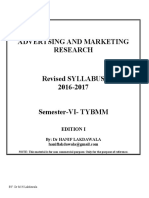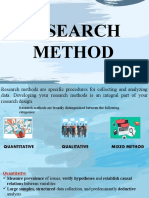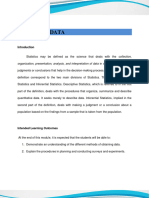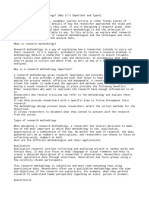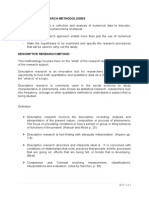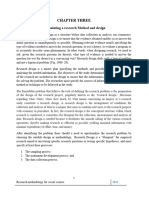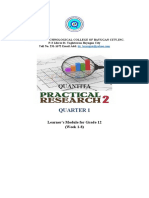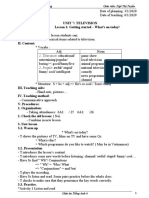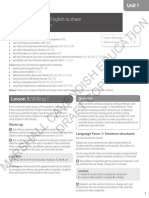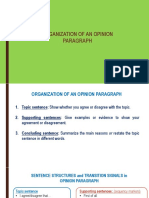Reviewer in PR2
Reviewer in PR2
Uploaded by
Farell BanuelosCopyright:
Available Formats
Reviewer in PR2
Reviewer in PR2
Uploaded by
Farell BanuelosCopyright
Available Formats
Share this document
Did you find this document useful?
Is this content inappropriate?
Copyright:
Available Formats
Reviewer in PR2
Reviewer in PR2
Uploaded by
Farell BanuelosCopyright:
Available Formats
Reviewer in PR2
Humans are 'intuitive' scientists .... always asking questions and testing theories about
themselves, others, events, the environment, and the world around them.
Research is asking a question and finding out the answer
We all engage in or do social research as we act on the basis and results of our own research
and theorizing, therefore, what we think affects the way we behave
We research people and their behavior, opinions, attitudes, trends, and patterns, also politics,
animals, health, and illness.
Research can be conducted either informally for our own benefit
Research may be carried out in our own lives
Our views - personal, social, community and worldwide and our own identities are socially constructed
through our own theorizing.
Research gives us information about:
1. Thoughts and opinions
2. Attitudes
3. Habits
4. Culture
5. Norms
6. Scientific facts
7. Medical information
We research in order to understand society and social processes, as well as to test and or
create theories in order that we are better able to inform about social action and potentially
'improve' social conditions.
Social Research Methods are the tools used to explain social phenomena and often it is more possible
to challenge conclusions if you are at least conversant with the variety of methodologies and tools
applied.
TYPES OF RESEARCH METHODS:
Quantitative
trying to quantify things
look to quantify data and generalize results from a sample of the population of interest
to measure the incidence of various views and opinions in a chosen sample
AIM: The aim is to count things in an attempt to explain what is observed.
PURPOSE: Generalizability, prediction, causal explanations
TOOLS: as surveys, to collect numerical data
DATA COLLECTION: Structured
OUTPUT: Data is in the form of numbers and statistics.
SAMPLE: a large number of cases representing the population of interest. Randomly selected
Respondents
OBJECTIVE/SUBJECTIVE: seeks precise measurement & analysis
RESEARCHER ROLE: Researcher tends to remain objectively separated from the subject matter.
ANALYSIS: Statistical
Qualitative
concerned with a quality of information
to gain an understanding of the underlying reasons and motivations for actions and establish
how people interpret their experiences
provide insights into the setting of a problem, generating ideas and/or hypotheses
AIM: The aim is a complete, detailed description of what is observed.
PURPOSE: Contextualisation, interpretation, understanding perspectives
TOOLS: Researcher is the data gathering instrument.
DATA COLLECTION: Unstructured
OUTPUT: Unstructured
SAMPLE: a small number of representative cases. Respondents selected on their experience
OBJECTIVE/SUBJECTIVE: individuals’ interpretation of
events are important
RESEARCHER ROLE: tends to become subjectively immersed in the subject matter
ANALYSIS: Interpretive
CHARACTERISTICS OF QUANTITATIVE RESEARCH
Your goal in conducting quantitative research study is to determine the relationship between
one thing [an independent variable] and another [a dependent or outcome variable] within a
population.
Quantitative research designs are either descriptive [subjects usually measured once] or
experimental [subjects measured before and after a treatment].
A descriptive study establishes only associations between variables
An experimental study establishes causality.
deals in numbers, logic, and an objective stance
focuses on numeric and unchanging data and detailed, convergent reasoning rather than
divergent reasoning
Four (4) main types of quantitative designs:
1. Descriptive research - a study designed to depict the participants in an accurate way.
• Observational - method of viewing and recording the participants
• Case study - an in-depth study of an individual or group of
Individuals
• Survey - a brief interview or discussion with an individual about a specific topic
2. Correlational study - a quantitative method of research in which you have 2 or more
quantitative variables from the same group of subjects, & you are trying to determine if there is
a relationship
3. Quasi-experimental design - involves selecting groups, upon which a variable is tested, without
any random pre-selection processes.
4. Experimental research - commonly used in sciences
a collection of research designs which use manipulation and controlled testing to
understand causal processes
The experimental method is a systematic and scientific approach to research in which the
researcher manipulates one or more variables, and controls and measures any change in
other variables.
an experiment where the researcher manipulates one variable, and control/randomizes the
rest of the variables
QUANTITATIVE RESEARCH METHODS
Surveys are a popular method of collecting primary data
Surveys are a useful a means of gathering data from businesses, community organizations
and residents, and survey research is one of the most important areas of measurement in
applied social research.
it is important to understand who you want to survey, how you are going to select them,
how you are going to survey them, what you want to ask them and how you are going to
organize the task
CENSUS - secondary data sources that will give you a population count
Sampling
The sample is the section of the wider population that will be engaged in the survey and
sampling is the process of identifying who you will aim to contact from that population.
‘Population’ - is used to describe the target group
Sampling frame - a list of members of a population from which members of a sample are
then selected
Statistical significance
Understanding your population, sample size, and response rates are important for
calculating interval and confidence levels, which are vital in determining how many people
you need to interview in order to get results that reflect the target population as precisely as
needed.
Format
Cross-sectional surveys - are used to gather information on a population at a single point in
time.
Longitudinal surveys - gather data over a period of time.
The three main types of longitudinal surveys are trend studies, cohort studies, and panel
studies
Questions
Closed questions – these have a number of possible answers in a list for respondents to
choose from
Ranking scales – these are most commonly used when trying to ascertain the level of
importance of a number of items.
Sliding scales – these are used to discover respondents’ strength of feeling towards an issue.
Administration
The costs, required facilities, time, and personnel needed to conduct an effective survey are
often underestimated.
The most common resource underestimated is time.
Surveys can be delivered in a variety of ways:
• Postal surveys;
• Telephone surveys;
• Email/internet surveys;
• Street surveys/administered surveys.
Survey data - is the question answers, such as ‘yes’ or ‘no’ or perhaps a number, where a person has
ranked a question on a scale
Web based programmes
Internet based survey tools - can distribute your survey via email and also collect your results, often
allowing you to view your results as they are collected in real-time.
Excel
Microsoft Excel - is useful for data summary, presentation, and for other basic statistical analysis.
Analysis ToolPak - a set of data analysis tools
Microsoft website.
SPSS (Statistical Package for Social Scientists)
- among the most widely used program for statistical analysis in social science.
- This is a data analysis package for quantitative research.
- It is particularly useful for the analysis of survey data as it covers a broad range of statistical
procedures.
You might also like
- LRP 6 q1 285 Pages in All LRP 6Document54 pagesLRP 6 q1 285 Pages in All LRP 6Dixon Labado0% (1)
- Day 4Document4 pagesDay 4Rodalyn Joy DizonNo ratings yet
- Tybmm - Advertising & Market Research NotesDocument87 pagesTybmm - Advertising & Market Research Notesstanvii100% (1)
- 7 DLL HOPE 3 2019-2020 JulyDocument2 pages7 DLL HOPE 3 2019-2020 JulyCelia BautistaNo ratings yet
- Basic Managerial SkillsDocument25 pagesBasic Managerial SkillsUday SharmaNo ratings yet
- RM Cia 1 1620203Document12 pagesRM Cia 1 1620203Aditya JainNo ratings yet
- Payal Chhangani (RMPPT)Document27 pagesPayal Chhangani (RMPPT)PayalNo ratings yet
- Quantitative and Qualitative As Research Based DesignDocument18 pagesQuantitative and Qualitative As Research Based DesignRandom KidNo ratings yet
- Unit 5 SociologyDocument2 pagesUnit 5 SociologyMukul KumarNo ratings yet
- Week11 PDFDocument5 pagesWeek11 PDFJude BautistaNo ratings yet
- Social Research 05032023 113509pmDocument12 pagesSocial Research 05032023 113509pmGhayyur MehdiNo ratings yet
- Admire S Mabhena Research Methods Ass 1Document3 pagesAdmire S Mabhena Research Methods Ass 1admire simbarashe MabhenaNo ratings yet
- Lecture 01 Overal Introduction 311Document4 pagesLecture 01 Overal Introduction 311Zovuyo MthanyanaNo ratings yet
- Research and Its Importance in Our Daily LifeDocument27 pagesResearch and Its Importance in Our Daily LifeSheila Mae LiraNo ratings yet
- Quantitative Research by MeDocument13 pagesQuantitative Research by MeAyoub yopiNo ratings yet
- EDA-Chapter-1 Batangas State UniversityDocument27 pagesEDA-Chapter-1 Batangas State Universitygerjoiroldan10No ratings yet
- ResearchDocument29 pagesResearchCharise Daitol LacnoNo ratings yet
- Assignment No. 1Document8 pagesAssignment No. 1GES ISLAMIA PATTOKINo ratings yet
- Advanced Research ReportDocument20 pagesAdvanced Research ReportJessaMae AlbaracinNo ratings yet
- Data Collection Sem OldDocument62 pagesData Collection Sem OldAmy Lalringhluani ChhakchhuakNo ratings yet
- Research MenthodsDocument20 pagesResearch MenthodsMerlyn SylvesterNo ratings yet
- ED 303 Handout Quanti vs. QualiDocument5 pagesED 303 Handout Quanti vs. Qualimaria.duran004No ratings yet
- Method of Collecting DataDocument6 pagesMethod of Collecting DatazeliaNo ratings yet
- ClassIn Inquiries Investigations and Immersion GRADE 12 2Document73 pagesClassIn Inquiries Investigations and Immersion GRADE 12 2loriaej346No ratings yet
- 06 Critical Appraisal of Qualitative Research 2Document27 pages06 Critical Appraisal of Qualitative Research 2Nayomi YviNo ratings yet
- DATA COLLECTION METHODS Communication StudiesDocument4 pagesDATA COLLECTION METHODS Communication StudiesjaylamarieNo ratings yet
- Chapter 3 - Software Development MethodologiesDocument35 pagesChapter 3 - Software Development Methodologieswork uploadNo ratings yet
- Qualitative & Quantitative ResearchDocument42 pagesQualitative & Quantitative ResearchAllenaNo ratings yet
- Sampling Practice and Research Methods Lecture NoteDocument80 pagesSampling Practice and Research Methods Lecture NoteAba MachaNo ratings yet
- Engineering Data Analysis Chapter 1 - Obtaining DataDocument10 pagesEngineering Data Analysis Chapter 1 - Obtaining Dataetdr4444No ratings yet
- Research DiscussionDocument6 pagesResearch DiscussionHayjackNo ratings yet
- Finals - ReviewerDocument17 pagesFinals - ReviewerCharmy Rose FranciscoNo ratings yet
- Research MethodologyDocument4 pagesResearch MethodologyMubarak AliNo ratings yet
- Difference Between Qualitative and Quantitative Literature ReviewDocument4 pagesDifference Between Qualitative and Quantitative Literature ReviewaflshvifmNo ratings yet
- App 005: Practical Research 1Document10 pagesApp 005: Practical Research 1ayannazxiNo ratings yet
- Conduct SurveysDocument36 pagesConduct Surveysjaysaalilano88No ratings yet
- Ares2 Lesson1Document7 pagesAres2 Lesson1Jochene Eve AldamiaNo ratings yet
- Lecture OneDocument29 pagesLecture OnemssoluwaferanmiNo ratings yet
- Research Methodology - N. Kavya SreeDocument8 pagesResearch Methodology - N. Kavya SreeKavya Reddy NadimpallyNo ratings yet
- Development of SociologyDocument17 pagesDevelopment of Sociologyfafoje8944No ratings yet
- Topic: The Continuum of Philosophy.: Quantitative ResearchDocument9 pagesTopic: The Continuum of Philosophy.: Quantitative ResearchHina KaynatNo ratings yet
- Research MethodsDocument45 pagesResearch MethodsAmos Makori MaengweNo ratings yet
- Accounting Research Methods Chapter 4Document81 pagesAccounting Research Methods Chapter 4Glaiza LerioNo ratings yet
- Business Research MethodologyDocument13 pagesBusiness Research MethodologyAakash RastogiNo ratings yet
- What Is Research: DefinitionDocument6 pagesWhat Is Research: Definitionwajid aliNo ratings yet
- PR2 2ndDocument28 pagesPR2 2ndjasmine fayNo ratings yet
- Research MethedologyDocument9 pagesResearch MethedologyRaghavendra KattiNo ratings yet
- Qualitative ResearchDocument15 pagesQualitative ResearchEstefania Penagos CanizalesNo ratings yet
- Quantitative ResearchDocument6 pagesQuantitative Researchceedosk1No ratings yet
- Survey DesignDocument11 pagesSurvey Designhajiwaheed0604No ratings yet
- Qualitative and QuantitativeDocument6 pagesQualitative and QuantitativeJacob Kennedy LipuraNo ratings yet
- PR2 Lesson 1Document5 pagesPR2 Lesson 1Marcco Juan MarccoNo ratings yet
- Report Quantitative ResearchDocument14 pagesReport Quantitative ResearchRomina Lucena Fajardo100% (1)
- Understanding Data and Ways To Systematically Collect DataDocument39 pagesUnderstanding Data and Ways To Systematically Collect DataTammyQuiwaHermosa100% (1)
- Research 2Document9 pagesResearch 2jhaitiman111No ratings yet
- Chapter 3Document18 pagesChapter 3Tasebe GetachewNo ratings yet
- 111Document3 pages111Anonymous AvQUH6No ratings yet
- Reflection 9-Communicating The Research Results: Research Presentation Abulencia, Jessa Mae PDocument6 pagesReflection 9-Communicating The Research Results: Research Presentation Abulencia, Jessa Mae PJESSA MAE ABULENCIANo ratings yet
- Quantitative Research Thus Reduces SubjectivityDocument10 pagesQuantitative Research Thus Reduces SubjectivityShukri MohaNo ratings yet
- Dept Education 1705 MED II SEM Qualitative ResearchDocument6 pagesDept Education 1705 MED II SEM Qualitative ResearchSoumyaNo ratings yet
- Note For Mid 1Document19 pagesNote For Mid 1Tafhimul IslamNo ratings yet
- Module ResearchDocument16 pagesModule ResearchMARIEL MUTUCNo ratings yet
- Module For P.R 2Document17 pagesModule For P.R 2Ryan SaladagaNo ratings yet
- Research Methods and Methods in Context Revision Notes for AS Level and A Level Sociology, AQA FocusFrom EverandResearch Methods and Methods in Context Revision Notes for AS Level and A Level Sociology, AQA FocusNo ratings yet
- Transform Your HabitsDocument14 pagesTransform Your Habitsapi-487922974No ratings yet
- Giáo Án t Anh 6 Mới Ki II Theo Ct Giảm TảiDocument85 pagesGiáo Án t Anh 6 Mới Ki II Theo Ct Giảm TảiNgo Tuyen Hung YenNo ratings yet
- Fill in The Blank - Benchmark B: The Design ProcessDocument5 pagesFill in The Blank - Benchmark B: The Design ProcessapplaniaNo ratings yet
- Ab Team Charter EditiedDocument3 pagesAb Team Charter Editiedapi-583327830No ratings yet
- Cambridge International AS & A Level: PSYCHOLOGY 9990/04Document10 pagesCambridge International AS & A Level: PSYCHOLOGY 9990/04shehzil000No ratings yet
- ResearchDocument3 pagesResearch11- WATSONS ABGAO, Matt ArgelNo ratings yet
- Teachers Manual in Filipino Grade 8Document2 pagesTeachers Manual in Filipino Grade 8Kmart Irving Ramos60% (25)
- Demonstrate What Culture Is and How It Influence Moral DevelopmentDocument2 pagesDemonstrate What Culture Is and How It Influence Moral DevelopmentJuan PerezNo ratings yet
- Kpi GuideDocument4 pagesKpi Guidetan nguyen vanNo ratings yet
- MCE IGCSE ESL Teacher's Guide Unit 1 SampleDocument11 pagesMCE IGCSE ESL Teacher's Guide Unit 1 SampleJinky ElaineNo ratings yet
- Background of The StudyDocument12 pagesBackground of The StudyAyessa AnchetaNo ratings yet
- Communicative Styles PDFDocument22 pagesCommunicative Styles PDFLeonor RicoNo ratings yet
- Organization of An Opinion Paragraph PDFDocument19 pagesOrganization of An Opinion Paragraph PDFCastañeda Torres Jorge100% (1)
- Influence of School Supervision On The Implementation of Commerce CurriculumDocument127 pagesInfluence of School Supervision On The Implementation of Commerce CurriculumKolawole Kolawole YUSUFNo ratings yet
- INTRO TO PHILO Budget of WorksDocument9 pagesINTRO TO PHILO Budget of WorksBethuel Pacasit AlquirozNo ratings yet
- Argument Structure in The Verb Phrase (VP) : Reach), EtcDocument8 pagesArgument Structure in The Verb Phrase (VP) : Reach), EtcPavelNo ratings yet
- 20 Essential+Phrases For IELTS SpeakingDocument13 pages20 Essential+Phrases For IELTS Speakingquangvan.tpaNo ratings yet
- Evaluation FormDocument3 pagesEvaluation Formnauman123No ratings yet
- Civil War Vocab Lesson - Differentiated 2Document4 pagesCivil War Vocab Lesson - Differentiated 2api-502287851No ratings yet
- Prof - Ed 8 TosDocument1 pageProf - Ed 8 TosBert Lloyd TumilapNo ratings yet
- Mind StyleDocument34 pagesMind StyleB V Rama Prasad100% (4)
- TakeawaysDocument2 pagesTakeawaysiMaibelle BelleNo ratings yet
- Health 10 Quarter 1 - Week 8 Programs For Consumer Welfare and ProtectionDocument3 pagesHealth 10 Quarter 1 - Week 8 Programs For Consumer Welfare and ProtectionKevin Bulanon0% (1)
- Course ReflectionDocument4 pagesCourse Reflectionapi-272402965No ratings yet
- 3 I's Scope and DelimitationDocument3 pages3 I's Scope and Delimitationjohn erick acuninNo ratings yet


